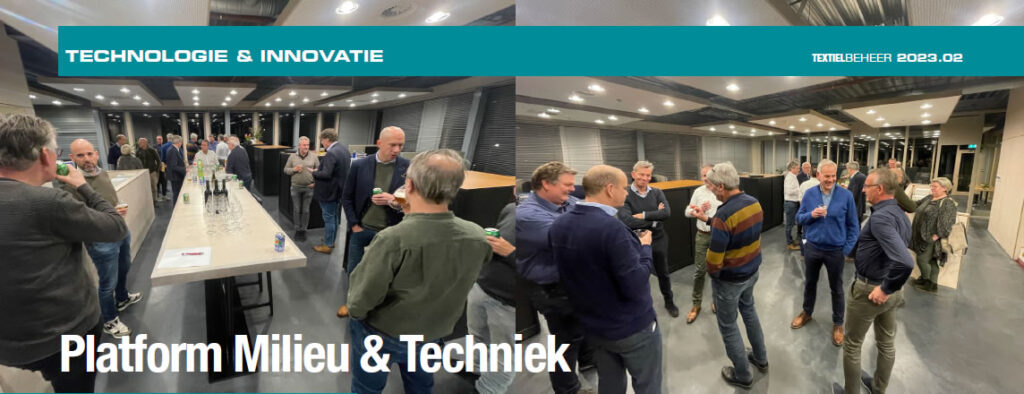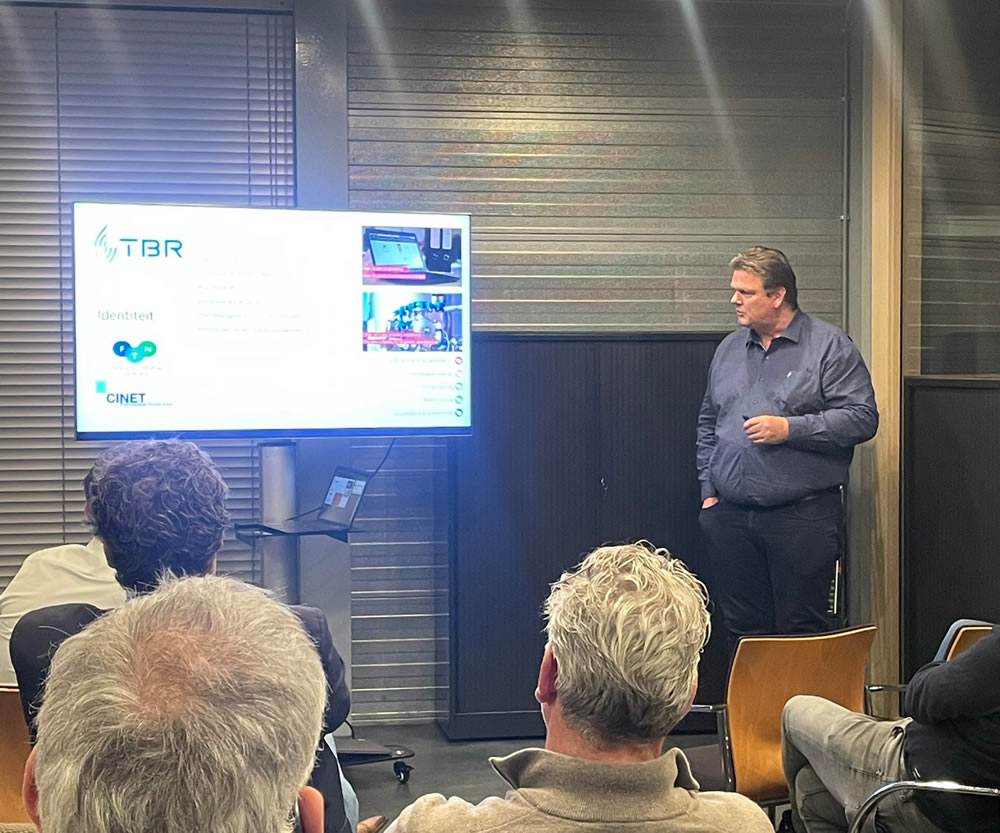
TECHNOLOGY & INNOVATION
From: TEXTIELBEHEER | FEBRUARY 2023
Journal for the textile care industry
On January 19th, another meeting of the E&T (Environment and Technology) platform of FTN took place. It was the first physical meeting this platform has had since the start of covid. The meeting took place in the new branch office of FTN in Gorinchem, and for most people it was their first time visiting this location. 24 members had applied for this meeting, which, together with the speakers and employees of the bureau, resulted in a welcome sense of crowdedness.

The organization had put together a varied program, with a number of presentations and room for input from the members. Rudolf Vendrig, chairman of M&T, welcomed those present on behalf of FTN.
TKT projects 2022
Henk Gooijer of TKT then took over and gave a short presentation about the projects that were completed by TKT in 2022:
- Mass balance textile care
- Lifespan
- No more gas
- Microplastics
As part of the information provision for EPR, which Arthur Linssen spoke about later that evening, a study was conducted by TKT in 2021, looking into textile waste from the textile service industry. The study showed, among other things, that the textile service sector already largely meets the requirements for textile reuse and recycling as set out in EPR.
Figure 1 below clearly illustrates that only a very limited part of the waste from our industry is incinerated. Another result of the research was that 13% of textiles are lost at the customer. The response from those present was that, in their opinion, this should add up to much more. Numbers up to percentages of 80% were mentioned that would allegedly be lost at the customer.
The second project presented by Henk Gooijer was the industry’s contribution to the development of a new standard measurement method for measuring microplastics in wastewater. The results of this were already discussed in detail in the previous issue of Textielbeheer.
A third project involved doing research into the effects of lifetime extension on the sustainability of textile use. Interestingly, the study found that consumers only wash a piece of clothing 7-10 times on average. This is much less than would be technically possible. In the research done by TKT, the FTN Ecotool was used to calculate the effect of this potential lifespan extension on the sustainability of textile use. And the results were quite impressive! Figure 2 shows the effect of the number of washes on CO2 emissions and water consumption for a cotton shirt.
In other words, this means that with an extension of the lifespan from 10 to 20 washes, CO2 emissions and water consumption per moment of use are almost halved! Henk Gooijer emphasizes that this has shown that extending the lifespan is an incredibly effective means of improving the sustainability of textiles and that we as an industry must make it clear that washing is not an environmentally harmful process, but rather a means of improving the sustainability of textile use as a whole.
Finally, the No more gas project was presented. The conclusion of this study was that hydrogen seems to have the best credentials in the medium and long term to make natural gas the most important source of heat, particularly in the drying processes. For this to succeed, green hydrogen needs to become available on a large scale.
EPR
Arthur Linssen then gave a short introduction about EPR (Extended Producer Responsibility). EPR textile is coming! The aim of EPR is that in the coming years less textile will be incinerated and much more will be reused or recycled. EPR makes textile importers and manufacturers responsible for the collection, sorting, reuse and recycling of textiles in the Netherlands. To achieve this, the sector organizations Modint and InRetail have set up a producer organization that will be responsible for implementing EPR, an organization that textile importers and manufacturers can join. This organization will take over the responsibility for achieving the objective from the individual parties and will therefore levy an additional charge on textiles, comparable to the disposal fee on white goods, for example. It is expected that EPR will be formally approved before the summer and that the levies will be introduced from the 1st of January 2024. Arthur Linssen suggested that, as the mass balance for Textile Care shows, the sector already largely meets these objectives and that FTN therefore suggests that the textile service should fall outside EPR. Unfortunately, there was no agreement on this front. The aim is now to define the conditions for participation the textile service industry as favourably as possible.
TKT projects 2023
Henk Gooijer then briefly presented the Leave your laundry out the door project. The aim of the project is to provide insight into the advantages of professional washing compared to home washing in terms of sustainability and quality. In addition, potential topics for projects were discussed, such as a project idea to further investigate the effect of filters on microplastic removal. Energy saving is a hot topic due to the increasing energy costs, and the attendees indicated that there is great interest in projects for new developments to save energy, such as the application of heat pumps in the laundry or cascade drying, as presented by Lavatec at the ExpoDetergo.
In addition, Henk Gooijer reported that an Innovation Fund will be set up through EPR, which will finance research and developments whose results can help to achieve the objectives of EPR. In order to sort this out, TKT has already drawn up five ideas for projects, which were received positively by those present:
- Sustainability analysis tool
- Lifespan extension
- Recycling textile waste from the laundry
- Recycling of functional textiles
- Use of recycled material
Finally, the EPI (Energy Performance Inspection) was briefly mentioned. The EPI is an efficient method with which companies can demonstrate that they comply with the legal obligation to save energy. For many companies, the EPI expires in 2023. TKT can carry out the EPI for companies, interested parties can contact FTN for this.
Developments in energy purchasing
Frank von Reeken from BMD Advies then gave a short presentation about developments in the field of energy prices. His presentation showed how complex the energy market is and how all kinds of developments, such as the war in Ukraine, the weather, and covid influence the price of energy and that prices have been falling steadily since the peak of summer 2022. This development also seems to be continuing in the long term, on the understanding that prices will remain high compared to those of a few years ago (see figure 3 for the gas price). Of course, these expectations offer no guarantees for the future.
Frank von Reeken also indicated that the availability of gas on the market will be finite in the long term and that the energy transition in the Netherlands is expected to gain momentum.
From inspiration to energy saving
Wijnand ten Broek from Laundry Dashboard showed in a presentation that the availability of the correct process information in real time and the possibility to take action based on this in real time can be the key to significant savings. This not only concerns energy savings, but also cost savings and an increase in productivity.
Laundry Dashboard is a tool that enables laundries to make the right decisions at the right time based on data. In the presentation, a case was presented in which the drying process for terry cloth was optimized using Laundry Dashboard, resulting in an energy saving of 10% on the drying process and a reduction of the drying cycle by 5 minutes. The condition for this data is of course the presence of meters and sensors in the company, which Laundry Dashboard can advise on.
Application of a heat pump in the laundry
The last presentation was held by Jaap Reinders of TBR. In his presentation, he showed how TBR has contributed to significant progress in energy efficiency in the laundry industry over the past decades. Examples of these developments are the steamless laundry, the Heat-X Rotor for recovering heat from the waste water, the Heat-X air heat exchangers for recovering heat from the drying air of dryers and ironers, but also the use of solar collectors for heating process water.
During the M&T meeting, TBR’s latest innovation was presented: a heat pump for heating the washing water. This technology was first installed at Moderna in Hardenberg. Jaap Reinders emphasizes that the application of the heat pump is the last step in an integrated system to recover heat. The first steps for heating the washing water are taken with solar collectors, a waste water heat exchanger and the Heat-X Air heat exchangers on the ironers. The heat pump only comes into the picture to remove the last bit of water from the waste water, where the waste water is cooled to 15°C, and the heat pump uses this leftover low-grade heat to heat the washing water to 60°C.
TBR emphasized the importance of good cooperation with the client and the will of Moderna to take steps, because otherwise these developments cannot come about. To be on the safe side, the installation was designed in such a way that there was always a hot water boiler on standby. However, this turned out not to be necessary in practice, which was confirmed by Gert Stroeve of Moderna.
The meeting was concluded with a drink, which provided sufficient reason to discuss the items that had been discussed during the afternoon and evening.
Figure 1) Destination of textile waste
Figure 2) Effect of lifespan extension on water use and CO2 emissions per time of use
Figure 3) Gas price overview (BMD advice)
Figure 4) Heat Pump (TBR)
Table 1) ) The objectives of EPR textiles
